New products at Crocus
by Sarah - April 30th, 2010.Filed under: Crocus, New Products.
New lines at Crocus
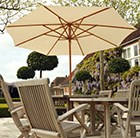
3m-ecru-hardwood-parasol £59.99
TEXT Below NEEDS CONFIRMINGThis large sunshade is the perfect finishing touch for a furniture set and has a crank mechhanism to open and close it. FSC certified hardwoodParasolDimension 3m diameter100% heavy weight polyester (160g/m2.)Treated with a water repellerDouble stitched heavy duty corner pocketsFSC certified hardwood8 strong wooden ribsAir vent at top of the parasolCrank opening/closing mechanismBrass plated screw-in pole connector48mm poleParasol base and cover not included can be purchased separately see below.
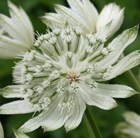
masterwort £8.99
Position: full sun or partial shadeSoil: fertile, moist, preferably humus-rich soilRate of growth: average to fast-growingFlowering period: June to AugustFlowers: greenish-whiteOther features: the flowers are excellent for cutting and dryingHardiness: fully hardyThe large, greenish-white flowerheads look like pincushions surrounded by a spidery ruff of green-tinted, white bracts. These are produced en masse above the lobed, dark green leaves from early summer to autumn adding bobbles of colour to the border. Astrantias have become the ‘darlings of the designers’ in recent years as they lend themselves to most styles of planting, and mix happily with most plants.Garden care: Incorporate plenty of organic matter when planting and water well in dry weather especially newly established plants. Lift and divide large clumps in early spring and apply a generous 5-7 cm mulch of well-rotted manure or garden compost around the plant. Divided specimens may take some time to establish since they don’t like having their roots disturbed.

haws-oval-fine-spray-brass-watering-can-rose £8.99
This rose is made completely from brass and produces a fine spray. The replacement brass rose is compatible with the professional range of outdoor watering cans as well as the Deluxe Plastic and Pink and Green 5 litre matal cans
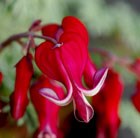
bleeding heart £8.49
Position: full sun or partial shadeSoil: moist, humus-rich, preferably neutral to slightly alkalineRate of growth: averageFlowering period: March to SeptemberHardiness: fully hardyThe dark red, heart shaped flowers have a raspberry ripple-like white edge to the petals, and these dangle like jewels from arching stems for a long period throughout spring and summer. The ferny foliage is a distinctive grey-blue colour which contrasts beautifully with the flowers. It forms mounds, which remain neat throughout the growing season, and is dies back later than many other varieties. This is a longer blooming and more drought tolerant cultivar. Garden care: Dicentras are happy in any good garden soil that is fertile but not too heavy. Enrich the soil with plenty of leaf mould before planting and apply a mulch in autumn too. This plant will appreciate a light top-dressing with fertiliser in March.
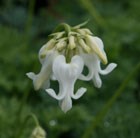
bleeding heart £8.49
Position: full sun or partial shadeSoil: moist, humus-rich, preferably neutral to slightly alkalineRate of growth: averageFlowering period: April to MayHardiness: fully hardyArching sprays of dainty, ivory flowers like lockets appear in late spring high above pretty, fern-like, blue-green foliage. Easy to grow, this variety is compact and has a long flowering season. It looks fabulous planted in groups towards the front of a shady border or as part of a cottage garden scheme. As long as the ground is kept moist, it will thrive in full sun or partial shade.Dicentras are northern hemisphere plants, growing from Asia to North America. In their natural habitat they are found in moist soils in the cool margins of woodlands. This dicentra was first introduced in 1816, then disappeared from cultivation but was reintroduced by plant collector Robert Fortune in 1846. It soon became one of the most popular garden plants. Garden care: Dicentras are happy in any good garden soil that is fertile but not too heavy. Enrich the soil with plenty of leaf mould before planting and apply a mulch in autumn too. This plant will appreciate a light top-dressing with fertiliser in March.
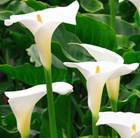
arum lily £7.99
Position: full sun or partial shadeSoil: humus-rich, moist soilRate of growth: average Flowering period: May to June Flower colour: pure whiteOther features: all parts may cause stomach ache if eaten and the sap can irritate the skinHardiness: full hardy (borderline)Unusual, pure white hood-shaped flowers that are up to 10-15cm (4-6in) long are produced from late spring to mid-summer. It makes a striking architectural clump with lovely arrow-shaped, glossy dark green leaves. It looks great grown beside water as a marginal plant and can be left outside in most frost-prone areas if it is given a deep winter mulch.Garden care: Grow in moist soil or as a marginal plant in a basket with heavy loam soil in water 30cm (12in) deep. Mulch plants well in winter.
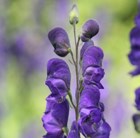
monkshood £6.99
Position: sun to partial shadeSoil: moist, fertileRate of Growth: averageFlowering period: July to AugustHardiness: fully hardyThis stately monkshood produces erect spikes of hooded,violet-blue flowers in mid and late summer above deeply divided, dark green leaves. Although it will take some sun, it is perfect for the back of a shady border, where it needs little attention. The stems seldom need staking and, since all parts of the plant are highly poisonous, pests tend to leave them well alone.Garden care: Prepare an extra deep planting hole at least 45cm (18in) deep, adding well-rotted organic matter to prevent the soil from drying out in summer. Deadhead to the next row of buds to prolong flowering. Always wear gloves when working with monkshood since all parts of the plant are poisonous and a potential skin irritant.
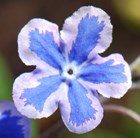
navelwort £6.99
Position: partial shadeSoil: moist, moderately fertile, humus-rich soilRate of growth: fast-growing Flowering period: March and AprilHardiness: fully hardySprays of gentian-blue, star-shaped flowers with a pale lilac edge appear in March and April among heart-shaped, mid-green leaves. This fast-growing, evergreen perennial will quickly form a vivid carpet in areas between deciduous shrubs and trees. An excellent companion for ferns and other shade-loving woodland plants, it prefers moist, moderately fertile, humus-rich soil.Garden care: Incorporate lots of well-rotted leafmould, composted pine needles or garden compost when planting. Lift and divide congested colonies in spring.
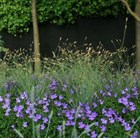
nest moor grass £6.99
Position: grows in both full sun or lightly dappled shadeSoil: moderately fertile, well drained, neutral or slightly alkalineRate of growth: averageFlowering period: July to OctoberHardiness: fully hardyA native of central and southern Italy, this gorgeous little grass is grown mainly for its colourful foliage. It forms dense mounds of pale grey-green to grey-blue leaves, which stay on the plant throughout the year. In spring it throws up whitish green cone-shaped flowerspikes, that bobble about in the breeze. Once established it can be very drought tolerant, and it looks great in a herbaceous or mixed border or wildflower meadow.Garden care: Gently comb through the foliage in spring to remove some of the older foliage and to encourage fresh new growth.
dahlia £6.99
verbena £6.49
meadow rue £5.99
rock bells £5.99
ice plant £5.99
wood cranesbill £5.99
false goatsbeard £5.99






